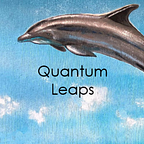LEADING AT THE EDGE OF CHAOS…
We are co-creating an international collaboration with a focus on leadership, education, innovation, and wellbeing. Our guiding principles are to imagine a better world and empower collective wisdom. We model ethical, empathic, self actualization — a transdisciplinary approach (future technologies) to systemic innovation.
“Anyone who is not shocked by ‘Quantum Physics’ has not understood it.” Neils Bohr.
Quantum Physics, as our most perceptive science, best explains our reality and yet, in terms of human development and achievement it’s a discovery that is nearly 100 years old. Its implications are profound and not just in scientific terms — it has a far reaching cultural impact in how we define leadership and relationship in the 4th Industrial Age. It is only in the past few decades that we have begun to understand the significance of Leadership in Complex Adaptive Systems — which mirrors the thinking behind the decisive ‘collapsed wave function’ in quantum physics. A process that helps us to understand and define our understanding of relationships and leadership at a deeper, more profound level of existence.
These ideas are extolled by the legendary Gell-Mann, the Physicist who invented the term ‘Quark’ and won the Nobel Prize for Physics — a keen proponent of Complex Adaptive Systems in organisational learning, both at an individual and collective sense. Working with Fortune 100 companies and top scientists in the world we have developed ‘Quantum Leadership Processes’ that defy our common understanding of what Leadership actually means. Leadership and adaptability go hand in hand and it goes beyond our current understanding of Innovation and into the realm of quantum problem solving in Leadership Processes such as Systemic Innovation. This highlights the importance of relationships at a subatomic level that also manifests itself in neural networks and biological systems thinking.
“An observing Complex Adaptive System determines the regularities and irregularities that help organisations to solve problems and make predictions about future developments and technologies.” Murray Gell-Mann.
Over the past few years, we have been engaged in dialogues across the globe about these shifting paradigms and the opportunity for humanity to envision and move toward a collective mode of intelligence, one that goes beyond the limits of our current imagination, a place where we can live and function in a state of shifting perspectives and unifying holistic thinking. With time, we have come to crystallize our experiences to a higher level of consciousness aligned with Systemic Innovations, focused on biomimicry and design principles of generative cultures. We look to nature and our neurological evolution for wisdom about how to engage in a relationship with ourselves, with others and with our world.
With a focus on ‘Quantum Leadership Processes’ as a way of educating and building community, we have come to see life and the expression of creativity as integral to human beings’ perception and flourishing — and in that end, the pursuit and purpose of education as paramount to the next iteration and evolution of our species. Human development is leadership development, is civilization development. To lead, we must follow, to follow, we must lead and in order to do both, we must first begin with self-awareness, empathy and systems thinking — indeed Complex Adaptive Systems which helps us to understand and more accurately perceive our reality. We are called to go beyond politics and tribalism to seek an understanding of our world that encourages a collective wisdom and harmonises the group with individual aspirations. In this way, we begin to perceive the world beyond our limited constructs and open up to the possibility of self actualisation — reaching our true potential.
What does this mean? Simply, we are suggesting that we must deconstruct and reconstruct all of our dated ways of knowing, thinking and being. We can do this with a generalists’ spirit of understanding a little about a lot and connecting the dots: from physics to early childhood education to governance to philosophy to change management to matters of the heart, we are seeing so much progress and data that in order to gain clarity through the cacophony of ‘noise’ — we need to become in tune with ourselves and learn to ‘perceive’ reality differently — dismantling limited belief and assumptions, leaning into complexity, ambiguity and chaos in order to be lifted by a sublime universal force that we often see in nature. What we focus on gets magnified and now there is scientific neurological evidence that connects the behaviour of Quantum Particles to organisational development and leadership. Our brains are constantly wired and rewired — whether we are aware of it or not — by the way our societies and civilizations are designed and now, by the technologies we use. In the interaction between humans and the machine — we must be truly aware of our own shortcomings as biological creatures and use emerging technologies (artificial intelligence, machine learning, quantum computing, etc.) to advance the human spirit in a way that evaluates our current thinking and prepares us to create value for all and for a better future. As we co-design at the moving edges of chaos, we need to consider the ethical implications of our decisions as they impact our past, present and future.
We have been very much impacted by Classical physics and centuries old Greco-Roman ways of thinking — we are currently living a renaissance of new thought, spirituality and wisdom — now with a bona fide science to back it up. With the advent of new trade routes, digitalism and the globalization and cultures of shared meaning, we are trying to adapt, survive and thrive in a world that is constantly changing, dynamic and in flux. This observed continual movement also means we are now open to a better understanding of our fragmented whole and how we need to adapt to and be mindful of our full evolutionary potential.
Co-authored by John Rainford and Mariam Hashemi
(Connect with us on LinkedIn)
